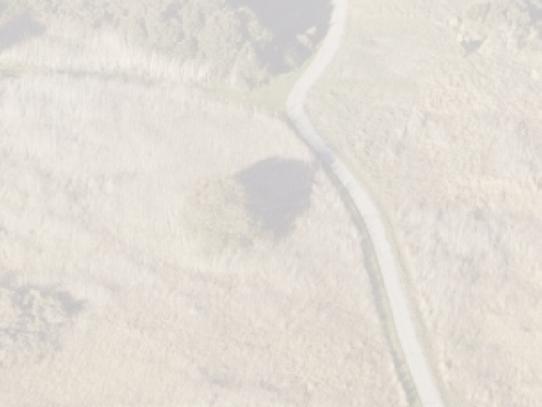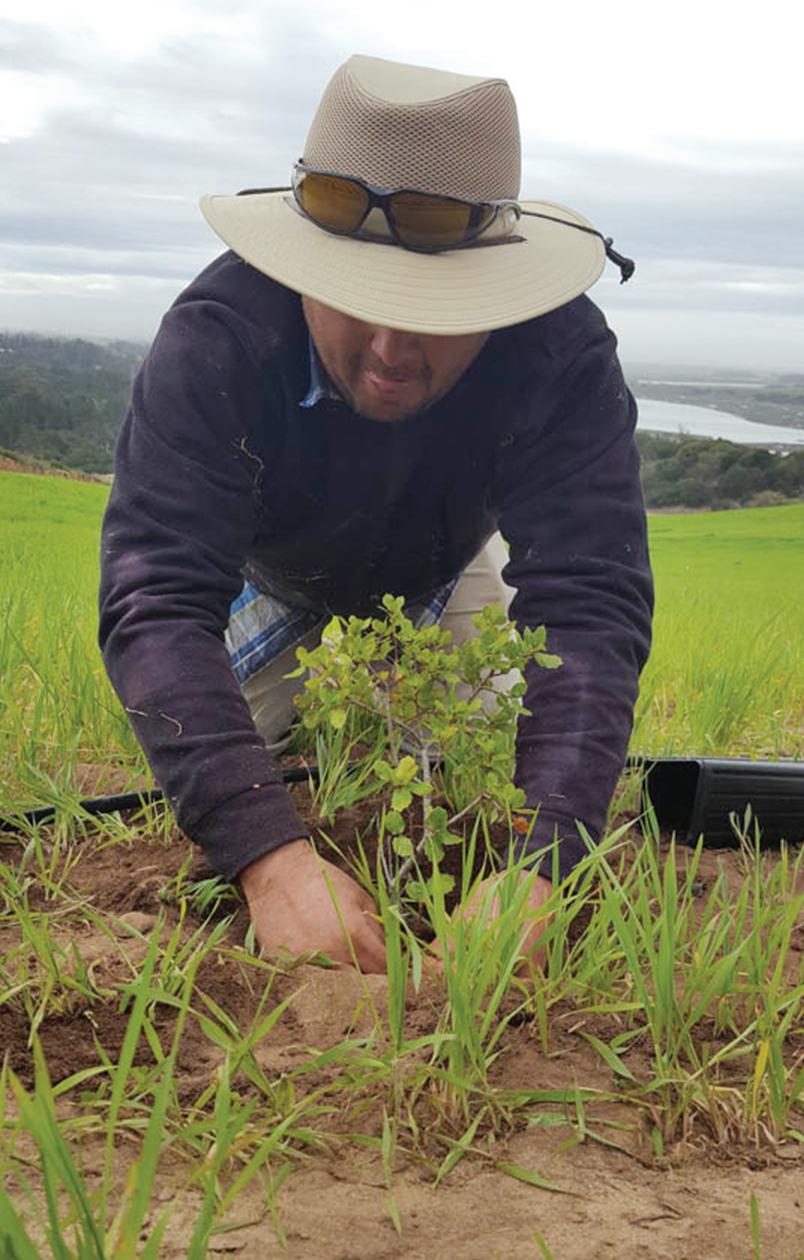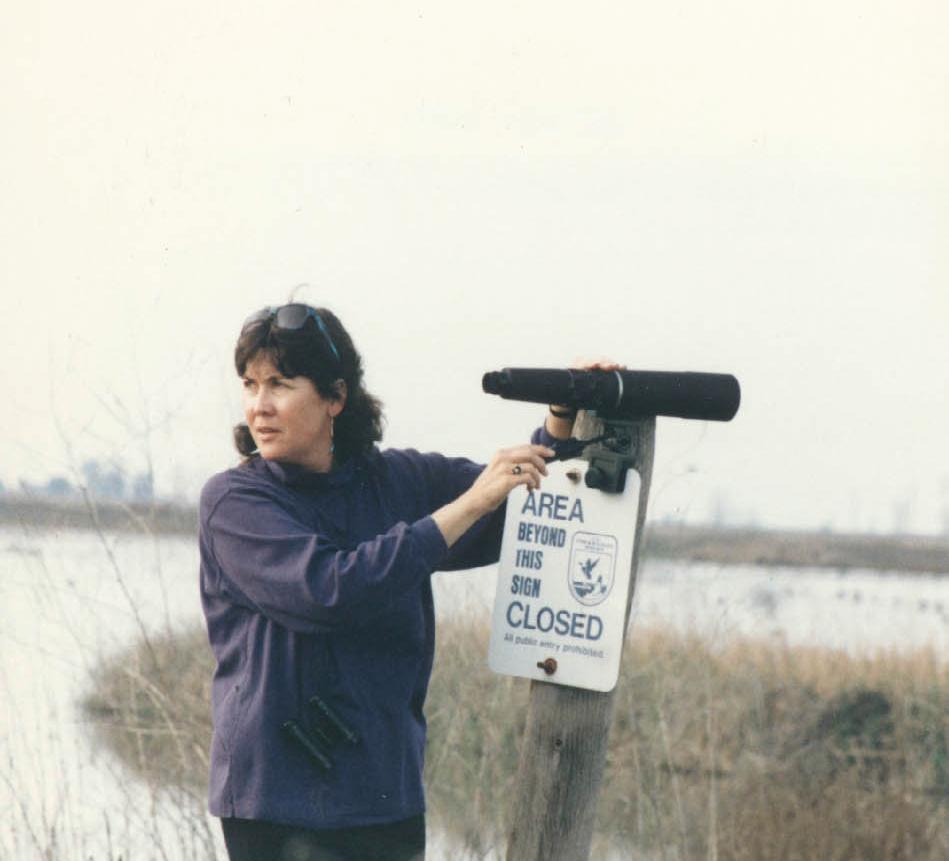

Tidal Exchange










Elkhorn Slough Reserve
Forty years ago, as nearly every coastal wetland on the California coast was being lled and developed, some good local people put the Elkhorn Slough on a di erent trajectory. Now — instead of seeing condominiums, marina communities, and engineered channels — we see harbor seals, sea otters, open space, an incredible diversity of bird life, and smiling faces exploring this special place. All this was made possible with the designation of the Elkhorn Slough Reserve in 1979, and the valuable partnerships that came together as a result.



When the National Oceanic and Atmospheric Administration created the National Estuarine Research Reserve System, they unleashed a potent model, with the federal government working in partnership with a state conservation agency at each site around the coastal United States. at model morphed into an incredibly productive working environment here at Elkhorn Slough.

ESNERR (2012), aerial photo by Keith Ellenbogen (Continued on page 2)

Elkhorn Slough Foundation

Anne Olsen
President
Robert Hartmann
Vice President
C. Michael Pinto
Treasurer
Bruce Welden
Secretary
Judith Connor
Past President
Gary Bloom
Ed Boutonnet
Terry Eckhardt
Sandy Hale
Emmett Linder
Kent Marshall
Murry Schekman
Laura Solorio, MD
Tara Trautsch
Mark Silberstein
Executive Director

Elkhorn Slough Reserve
e mission of the Elkhorn Slough Foundation is to conserve and restore Elkhorn Slough and its watershed.
We see Elkhorn Slough and its watershed protected forever— a working landscape, where people, farming, industry, and nature thrive together. As one of California’s last great coastal wetlands, Elkhorn Slough will remain a wellspring of life and a source of inspiration for generations to come
PO Box 267, Moss Landing California 95039
tel: (831) 728-5939
fax: (831) 728-7031
www.elkhornslough.org
Scott Nichols, Editor
(Continued from cover)
Our triumvirate structure — NOAA, the California Department of Fish and Wildlife, and the Elkhorn Slough Foundation — brings many resources to bear to help the Elkhorn Slough. is relationship has also spawned many other partnerships that have enabled us to tap into still more expertise and grant funds.
As Peter Douglas, long time director of the California Coastal Commission said, “ e coast is never saved. It’s always being saved. Our work, your work, is a labor of love that is never nished.”
Our work — your work — has evolved, has matured, has become more sophisticated. As we look forward to our next 40 years, it’s gratifying to re ect on what we’ve learned, how we’ve applied that knowledge and what we see happening in the future.
For example, our understanding of why we’ve lost much of our salt marsh has increased tremendously — yet our even our growing knowledge is never fully complete. is learning, though, has advanced our habitat restoration techniques. New technology has found its way into virtually every aspect of our work. In the case of the Hester Marsh restoration, technology enabled tractor operators to chart their recreation of the marsh against a 1931 aerial image of the area, in real time, right from the cabs of their tractors. At Elkhorn Slough, the past is informing our future with a boost from technology.
Similarly, historical maps and journal entries from early California explorers are informing our stewardship e orts by showing us what habitats have covered our landscape through time, o ering us a glimpse of the past that gives insight into how we might restore the land in the future.
Of course, our community has always been a huge part of the Elkhorn Slough e ort. From the initial decisions to pursue conservation in our landscape to the thousands of volunteer hours generated by our docents — you make a di erence at the Reserve, every day.


In recent years, anecdotal sightings of unusual sea otter behavior by Reserve volunteers grew into a multi-agency study of sea otter behavior in our estuary. eir observations are essentially writing a new chapter in the life history of this iconic and beloved creature, and will inform its reintroduction into other estuaries on the west coast.
We strive to be an asset to our community, as well. Today every fourth-grader in North Monterey County will visit the Reserve. Elkhorn Elementary School sends kids to our afterschool program, and we regularly participate in career day events. Wherever we can, we o er young people the opportunity to get to know us and what we do, in hopes that they will dream of a future doing work like ours.
Our impact extends well beyond the boundary of the 1,700-acre Elkhorn Slough Reserve, well beyond the local watershed and beyond our State and national boundaries. Our impact is rooted in the idea that individuals can make a di erence when we work together. at is our labor of love — it is never nished, and neither are we.
— Dave Feliz, Reserve Manager
Power of Partnership

is issue of Tidal Exchange celebrates the 40th anniversary of the designation of the Elkhorn Slough National Estuarine Research Reserve (ESNERR), and highlights the impactful work we have been able to accomplish together.
Elkhorn Slough is a conservation success story, and our success is driven by productive partnerships. ESNERR is one of 29 reserves established nationwide through the National Oceanic and Atmospheric Administration (NOAA) to support long-term research, water-quality monitoring, environmental education, and coastal stewardship.
e California Department of Fish and Wildlife (CDFW) owns and manages the 1,700-acre Elkhorn Slough Reserve, including ve miles of public trails winding through a variety of rare habitats. In partnership with NOAA and the Elkhorn Slough Foundation, CDFW conducts education, research, stewardship, and volunteer programs. An active volunteer corps of more than 100 community members supports the ongoing work of the Reserve.
Since 1982, the Elkhorn Slough Foundation (ESF) has been the nonpro t partner of the Reserve. As a land trust with its mission to conserve and restore the Elkhorn Slough and its watershed, ESF now protects 4,200 acres of rare habitat — including oak woodlands, maritime chaparral, grasslands, coastal dunes, and wetlands. Working together, with the support of our community, our organizations accomplish far more than we could ever do alone.









Photo by JoEllen Arnold
Photo by Kiliii Yuyan





The Elkhorn Slough Foundation is very grateful for all the support our community has provided in 2019 to continue protecting and restoring Elkhorn Slough.
Native habitat restoration moves forward at Sand Hill Farm and on protected lands throughout our watershed, thanks to forwardlooking friends who contributed to our Monterey County Gives campaign, signed up as Sustaining the Slough monthly members on Giving Tuesday, and renewed their annual memberships during the holiday season.
The new year is looking bright — thanks to all of you!


Historical Ecology & Stewardship
Can understanding the past help us plan for the future? e Reserve stewardship team sure thinks so. As part of our science-based habitat restoration program, we use historical ecology to help set project goals. ough in our rapidly changing world, the past cannot provide a precise blueprint for the future, there is real power in understanding how nature worked before the large scale modi cations of the 19th and 20th centuries — modi cations like wetland draining, conversion of prairies to farms, and removal of groundwater for irrigation. Reserve sta have uncovered facts, landscape patterns, and natural processes that were etched in tidal wetland soils, archaeological sites, the journals and maps of early explorers, government reports and surveys, newspaper articles, botanical records, and even paintings and photographs. Taken together, these sources paint a picture of the Elkhorn Slough that is in some ways is familiar, but in other ways very changed.
For example, 200 years ago Elkhorn Slough was described as a tidal estuary, however freshwater inputs were much greater then, and included streams, springs, the Salinas River during the rainy season, and even the Tembladero Slough, which year-round drained freshwater lakes and marshes that once existed between Castroville and Salinas.
Today, this knowledge informs our plans for sound habitat management moving forward, and has helped us site the Hester Marsh restoration project and design its network of tidal channels; decide where new freshwater ponds might be most sustainable in the coming decades to help support fragile amphibian populations; and determine which plant communities to restore and where.
Our ultimate goal is not to restore the past, but to apply the lessons we can learn from history to chart a course of conservation for the future.
(Clockwise from top) A 19th century sketch of a ranch just north of Elkhorn Slough, before eucalyptus were planted at Seal Bend but after the railroad was built; Reserve Stewardship Coordinator Andrea Woolfolk surveys tidal salt marsh; a map of Bolsa Nueva land grant from the Mexican era (circa 1836), oriented with north arrow pointing up, o ers insights into the historical geography of the Elkhorn Slough and the dominant habitats of surrounding lands.
Long-term Monitoring
For 40 years, Elkhorn Slough Reserve sta and volunteers have kept their nger on the pulse of the estuary. e centerpiece of the Reserve’s long-term monitoring is our water quality program, sampling two dozen wetlands for more than 30 years (see elkhornslough.org/water for an interactive visualization of the data). From this we’ve learned that adjacent upland restoration improves water quality, and that tide gates and other water control structures impair water quality. We’ve also detected that water has been the warmest, and most acidic, in the past few years — signs of a changing climate.
Long-term monitoring programs at the Reserve also include a focus on habitats, and have documented loss of salt marsh habitat due to sinking and bank erosion over the past decades, but a gain in seagrass. Volunteers also collect monitoring data about many key animal species at the Slough. From this we’ve learned that oysters are declining and at risk of local extinction, while breeding herons are holding steady, and otter numbers have increased over time.
Monitoring data help prioritize conservation actions, and provide a vital baseline for tracking future changes in response to stressors, such as rising seas or warming waters, as well as in response to restoration.







Tidal Marsh Restoration
Imagine you could step back through time onto the tidal marshes of 40 years ago. You smell the pungent sulfur from the mud, feel the wind on your face and hear the shrill calls of shorebirds. Was it all that di erent from today? Yes!
What you cannot easily see is that tidal erosion over time has deepened and widened tidal channels and tidal marshes are showing more signs of subsidence. Extensive diking and draining of wetlands led to large swathes of degraded habitat and, as sea level rises, our marshes are more and more at risk of drowning. Forty years ago, tidal marsh restoration e orts in the slough were on the order of hundreds of square feet, today we are restoring marsh 100 acres at a time.
How did we get here? ere are fteen di erent agencies that have jurisdiction over the slough. Getting everyone to agree can be a challenge but the Tidal Wetland Program brings the best available science to coastal decision makers to ensure the Elkhorn Slough’s wetlands last far into the future.


Our Living Classroom
Squeals of delight echo across the grassland as a fourth-grader spots their rst chorus frog — these are the moments that inspire the education sta and volunteers at the Elkhorn Slough Reserve. Nearly 40 years ago, school children took a guided walk on the Reserve for the rst time, and experienced a feeling of awe when they took in their rst view of the Slough.
Today, that same sense of wonder resonates in each child who visits, guided by an education team committed to inspiring a love and understanding of this place, the watershed and wetlands of the Elkhorn Slough Reserve.
What started as guided nature walks have evolved into rich explorations of grade level themes that connect the students to the habitats of the Reserve. Students now immerse themselves in this place through eld investigations, Visitor Center activities, and observations in our beautiful microscope lab.
“Our programs are wonderfully rich for every student who visits,” says Reserve Education Coordinator Virginia Guhin. “Yet we saw opportunities to wade deeper into wetland ecology through partnerships with local school districts.” ese collaborations now support fourth-grade students in North Monterey, Pajaro Valley and Santa Cruz County with class visits and multiple eld trips.
e Elkhorn Slough Reserve is inspiring future decision makers and leaders. But the breadth and depth of our programing is best expressed in the smiling faces of the Reserve’s Estuary Explorers, an afterschool program in which we explore the Reserve with Elkhorn Elementary students from 2nd through 5th grade. ese students are developing a love and a passion for protecting this place. Many will return in high school and may one day return to share the Elkhorn Slough with families of their own.



Informing the Coastal Conversation
No protected area is an island (metaphorically!) ESNERR, for example, is surrounded by lands, waters, and watersheds with shared wildlife, connected habitats, water resources, biogeochemical and climatic processes, and myriad threats. Across the region, local and regional government leaders, planners, regulators, and land managers require solid information to help them improve their environmental stewardship. Unfortunately, it can be a signi cant challenge for many decision-makers to easily access current, science-based best management practices.
e Coastal Training Program (CTP), the youngest of the NERR system-wide programs, was launched in 2002 to address these needs. At the Reserve, CTP often partners with other programs to share new knowledge on a range of topics, such as the ecological impacts from poor marsh water quality and the bene ts of habitat restoration.
Reserve Education Coordinator Virginia Guhin leads a jubilant group of students from the Estuary Explorers afterschool program.
It Takes a Village
e Reserve provides sanctuary for both wildlife and people — a place to nd tranquility after a stressful week, or to seek solace in the songs of migratory birds.
Among our visitors are the regulars, with a trail map etched in their skulls. ere are the familiar faces spotted at events each year, expanding their knowledge and giving back — community builders who spread the word about the Elkhorn Slough’s value. en there are those who go a step further and become volunteers. Volunteers are interwoven with the fabric of the Reserve. From yanking out invasive weeds to tracking otters through the morning mist, these dedicated hearts have enhanced the work of our programs.
e Volunteer program began in 1983 with a group of passionate docents leading walks for the public and sharing the exciting new work developing on the slopes of the Slough. Today, there are more than a hundred volunteers who assist in every aspect of the Reserve’s e orts, from development to implementation. eir physical work creates progress, and their time supports our grants. It is no overstatement to say we could not succeed without these dedicated volunteers.
It takes a village to raise an estuary, and we have one truly dedicated village.
Facing page, clockwise from top: education volunteers guide students from the Estuary Explorers afterschool program as they restore the marsh edge with native plants; at the Reserve greenhouse, volunteers tend the thousands of native seedlings used in restoration projects on conservation lands throughout the Elkhorn Slough watershed; beyond the Reserve, Elkhorn Slough's Coastal Training Program hosts workshops, like this meeting of the Central Coast Rangeland Coalition, to share best practices for conservation.
Yet CTP also works with partners beyond the Reserve to host workshops around the region on water management, grazing for conservation of rangelands, and skills such as using Geographical Information Systems (GIS), facilitating collaborations, negotiating about environmental conservation, and improving risk communications. Although some of these workshops explicitly target participants from the Monterey Bay or Central Coast regions, others — especially those on the biology and management of sensitive species like the California tiger salamander — draw participants from throughout the state. Now in its 18th year, Elkhorn Slough’s CTP is helping decision-makers access the information and skills they need via workshops, and in the process, bringing diverse types of professionals together so they can connect and strengthen critical relationships across their organizations.


Reflections on the Slough
Caroline Rodgers, Elkhorn Slough Volunteer
Looking back on 40 years of conservation success at Elkhorn Slough, I think of my great grandfather who started farming here on the Spring eld terrace. I rst explored the slough as a child because he put down roots here, which I share.
After joining the second docent class in the early 1980s, I realized that Elkhorn Slough’s story is a heartening reminder of what is possible when a community works together to safeguard our natural treasures. Instead of lling the estuary and building condominiums, a nuclear power plant, and an oil re nery (ideas proposed in the 1970s), forward-thinking people set out to protect this watershed. Since Elkhorn Slough’s protection as a National Estuarine Research Reserve, this unique corner of the central coast has been recognized as a Wetland of International Importance by the Ramsar Convention, as a Globally Important Bird Area by the American Birding Conservancy, and has won numerous accolades and distinctions for its biodiversity.
Re ecting on the last four decades, it is safe to say that those committed neighbors who fought to protect this special place were wildly successful. ere is still much to do to safeguard the long-term health and vitality of the watershed, but Elkhorn Slough is living proof of what a small group of dedicated people can accomplish on behalf of wildlife and people alike. I salute 40 successful years of protection and restoration, and look forward to more to come.
Photo by JoEllen Arnold
Elkhorn Slough Foundation
P.O. Box 267
Moss Landing, CA 95039
������� ������ ������� is open to the public from Wednesday through Sunday, 9am to 5pm with docent-led tours every Saturday and Sunday at 10am and 1pm. For information, hours, and event details, visit www.elkhornslough.org
February 13 | Evenings at the Estuary: Love Letter to the Slough Celebrate your love for the Slough! Join staff, volunteers, and community partners as we share stories of success from the past 40 years. FREE!
April 18 | Coastal Cleanup on Elkhorn Road Lend a hand in cleaning up our watershed in the morning, and learn about micro plastics with hands on activities in the Visitor Center.
April 25 | ESF Spring Morning Kayak Enjoy a morning paddle on the waters of Elkhorn Slough for a unique perspective on the wildlife of the estuary and its surroundings. Registration required.
May 2 | Birding with Rick Fournier Spend a morning with local expert birding guide Rick Fournier and identify resident and migratory birds by sight, sound, and behavior. Registration required.



May 9 | World Migratory Bird Day Explore the diversity of birds through hands on games and craft s. The Microscope Learning Lab will be open for a specialty exploration of feathers. FREE!
May 16 | ESF Wildflower Walk Take a moment to stop and smell the flowers on a visit to conservation lands protected through your support of the Elkhorn Slough Foundation. Registration required.
May 21 | Evenings at the Estuary: Historical Ecology Learn how humans have used the Elkhorn Slough from Reserve Stewardship Coordinator Andrea Woolfolk — and cheer the ribbon-cutting for a new history exhibit. FREE!




